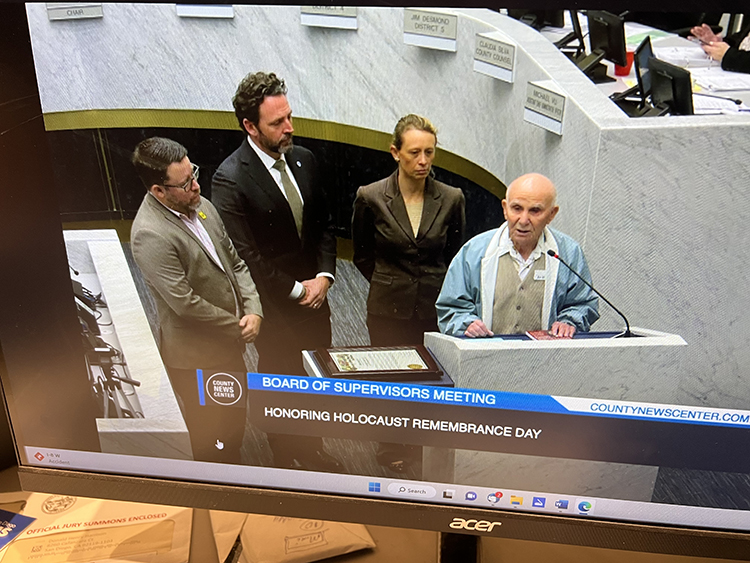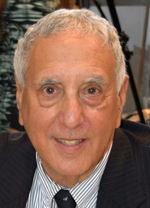
By Donald H. Harrison

SAN DIEGO – The San Diego County Board of Supervisors on Tuesday, Jan. 24, declared that day to be Holocaust Remembrance Day in San Diego County – three days before this coming Friday’s commemoration of International Holocaust Remembrance Day, coinciding with the 78th anniversary of the liberation of the Auschwitz Concentration Camp in 1945.
Following testimony of members of the local Jewish community, the Board of Supervisors also unanimously adopted a proposal by Supervisor Nathan Fletcher to provide a venue on county property for at least one year for a Holocaust exhibit focusing on the survivors who subsequently settled within the county. At the same time, it voted $25,000 for the Jewish Federation of San Diego County to administer the exhibit that will be curated by Sandy Scheller.
Scheller was the curator of “RUTH: Remember Us the Holocaust” exhibit that was named for her late mother Ruth Sax and had occupied the Chula Vista Civic Center Library for more than two years. It was closed much of that time, however, because of the COVID-19 pandemic. That exhibit, which focused on survivors who had moved to the South Bay region of San Diego County, will be expanded to tell the stories of survivors who live throughout the county, Scheller said. It also will include more graphic material on what happened during the Holocaust.
County staff has 60 days to find a suitable venue for the exhibit, which Scheller hopes to open on Yom HaShoah, the day on the Hebrew calendar that Israel and other parts of the Jewish world commemorate the beginning of the revolt in the Warsaw Ghetto against the Nazi German campaign of genocide. Yom Hashoah coincides this year with nightfall on Monday, April 17.
Explaining why he proposed the exhibit, Supervisor Fletcher said, “One of the best ways to counter conspiracy theories and the spread of hatred and antisemitism is educating the public by creating a space that fosters a better understanding of the Holocaust, its lessons, as well as the Jewish American experience.”
“Here in San Diego,” he added, “we don’t have a Holocaust museum or exhibit but we know we need one.” He said the temporary exhibit in Chula Vista was a “powerful and eye-opening experience” and expressed the hope that a new exhibit will be “one that will tell the story of the Holocaust survivors living in San Diego and reminds us of the lessons that we must never forget.”
The proposal, he said, “also serves as an expression of our resolute solidarity with our Jewish community and to let them know that this county stands with them and stands in stark contrast to those who threaten their way of life and their peace and safety. It is a commitment of us to stand against Holocaust denial and to stand against the spread of hate speech and disinformation.”
Terra Lawson-Remer, the lone Jewish member of the five-member Board of Supervisors, related that “three of my great-grandparents fled to the United States escaping the torture and mass killing of Jews in Ukraine, Lithuania, and Austria-Hungary.”
“We must rise up against antisemitism and bigotry,” Lawson-Remer said. “Hate has no room in our community. This day of remembrance shows us where this hate can lead. Today we honor the memory of the victims, embrace the survivors, and commit to keeping alive the promise of ‘Never Again.’”
Although Fletcher’s proposal was on the “consent agenda,” which meant that it was expected to be approved routinely, without debate by the Supervisors, at least a dozen persons delivered two-minute speeches either to support the proposal or to thank Fletcher and the Board of Supervisors for declaring the day honoring Holocaust remembrance. In so doing, they informed Fletcher, Lawson-Remer, Board Chair Nora Vargas, and Supervisors Joel Anderson and Jim Desmond what is being done locally in behalf of Holocaust survivors and Holocaust education.
Ben Midler, a survivor of the Auschwitz concentration camp who grew up in Bialystok, Poland, said that in 1960 the New Life Club of Holocaust Survivors was formed with a membership of approximately 400 people. Today, he said, there are only 35 left alive. Residing currently at La Costa Glen in Carlsbad, he said the residents there are mostly 70 and 80 years old “and they don’t know about the Holocaust.” This typifies the lack of knowledge in San Diego County, he suggested. “So this is why we have to have some place to start the exhibit. In the long run, we should have a museum in this city so people could know there was a Holocaust.” In the meantime, he said, he and fellow members of the New Life Club “are going every place. We go to speak about the Holocaust.”
Darren Schwartz, chief program officer at the Jewish Federation of San Diego County, told the supervisors that there are approximately 400 other Holocaust survivors living today in the county, most of whom live in poverty. Jewish Family Service programs help attend to their needs, he said, while the Anti-Defamation League educates teachers and students in a program called “No Place for Hate” that includes information about the Holocaust.
The heads of Jewish Family Service of San Diego (Michael Hopkins) and the San Diego region of the Anti-Defamation League (Fabienne Perlov) also spoke briefly to the County Board of Supervisors.
Hopkins told the Supervisors that the JFS staff “compassionately cares for Holocaust survivors throughout San Diego to assure that they age with dignity and with their health, independence and connection to our community.”
Noting the growing number of antisemitic incidents throughout the country, Hopkins said: “After living through one of the darkest periods of human history many survivors now face challenges that can trigger memories of traumatic experiences.”
“Lessons of recent years have taught us that it is not enough to react,” Hopkins said. “If we are not proactive against these forces that hurt and harm, they will continue to injure and become deadly.” He expressed the hope that the Holocaust Remembrance exhibit will “bring attention to what can happen when antisemitism goes unchecked.”
Perlov told the board that “Holocaust education has long been an ADL priority, something that goes hand in hand with our efforts to fight antisemitism and all forms of hate … We’ve seen a record number of antisemitic incidents here in San Diego County including 39 incidents of vandalism, harassment or assault” in the recent past. “We know that many incidents go unreported, but they all traumatize our community and especially survivors of the Holocaust.”
Leaders of two Holocaust education programs – Cheryl Rattner Price and Marcia Tatz Wollner – also addressed the Board.
Price is cofounder and executive director of the Butterfly Project which is in the process of memorializing the estimated 1.5 million children killed in the Holocaust with painted ceramic butterflies representing each one. Displays of the butterflies have been mounted throughout San Diego County and in other corners of the world. “Holocaust education is not easy but it is necessary and essential,” she said. “It is not a ‘one and done’ kind of program. It needs to be age-appropriate.”
Because of growing antisemitism, Price added “it is a very uncomfortable time right now.”
Wollner is the western regional director of the March of the Living, which sponsors two-week tours of Poland and Israel that take youths to Auschwitz-Birkenau and then on to Israel in time for Yom Ha’Atzma’ut (Israel Independence Day). She said the Holocaust remembrance exhibit will be an “opportunity to explore the horrors of the Holocaust, learn the lessons of the Holocaust, and learn that ‘Never Again’ is now. As a Holocaust educator, I see first-hand what our youth know, or indeed do not know, about the Holocaust. A recent survey of adults under 40 show that 60 percent have little knowledge of the Holocaust. It is time that San Diego take action. This exhibit is a first step to rectify the continued need for Holocaust education in our community.”
Sam Landau heads the San Diego Generations of the Shoah, an organization of children and grandchildren of Holocaust survivors. Besides people who don’t know about the Holocaust, there are people “who refuse to believe these numbers as well.” His own family experience was indicative of the extent of the genocide. “My mother was one of 11 children in a small town in Poland that is now part of the Ukraine. She and only two of her siblings survived the war. The rest of her family—her parents, her grandparents, her siblings, even those with children – were all murdered in the Holocaust. My father and a brother were the only two survivors in his family.”
“Sayings like ‘Never Forget’ and ‘Learn from the Past’ are just slogans unless steps are taken to make them become realities,” Landau warned. “This exhibit, I feel, is one of those situations where reality can occur …. These stories are personal; they become more than a statistic.”
Marie Raftery, former board chair of Jewish Family Service, agreed with Landau. “This exhibit is a step,” she said. “There are many Holocaust museums throughout the country. We aren’t there yet, but this exhibit is a big first step because it goes toward the education we so drastically need.”
David Beck-Brown, an artist, told the Board that his father-in-law helped to liberate a concentration camp. “When the other side knew that they were losing, as the Allies entered the camp, the camp guards shot and killed the inhabitants. The bodies were floating in the pool. He told them fish out the bodies, or they were going to join them. That was the only thing he told me about the war.” He said if a museum eventually is established, he plans to lend or donate various World War II artifacts that he has collected.
Scheller, the curator of the exhibit, said in addition to the people who testified before the Board of Supervisors, she had collected written statements in support of the exhibit from more than 100 people.
*
Donald H. Harrison is editor emeritus of San Diego Jewish World He may be contacted via donald.harrison@sdjewishworld.com
I will be sure to visit when I come to San Diego. My friend David Beck Brown has kept me informed about the good things done in San Diego for information about the Holocaust.
You are surely most welcome to visit, during times l’m not working…😆